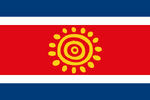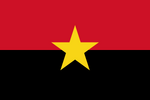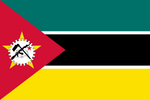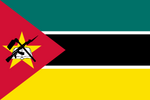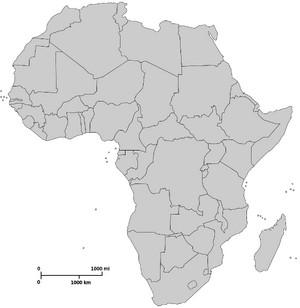
The nations south of the DRC/Zaire/Belgian Congo were in big trouble.
The issues[]
As a whole, the Portuguese Empire was hated by most Africans, who were also looking forward to eventual independence, for it's homicidal attitude toward separatist groups. The Pijiguiti Massacre in 1959 saw Portuguese soldiers opened fire on protesting Guinea-Bissau dockworkers, killing 50.
The nations south of the DRC/Zaire/Belgian Congo were in big trouble. Many wars and civil wars over the years due to the ongoing problems relating to the region's colonial legacy. The main problem was about the issues of spreading communism, Black rights, apartheid, the fall of the Portuguese empire, of Rhodesia under the racist Sir Ian Smith and the fate of White colonial ex-pats\business interests.
There were also brief incidents between India and Portugal over Dadra, Nagar Haveli and Goa.
The locations[]
.
Mineral resources[]
They had lots, but mostly untapped.
The conflicts[]
Angola[]
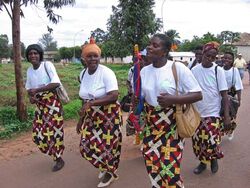
A women's peace group.

The challenge of creating growth and development in Angola - focus-0
There are many challenges for Angola. The country is hoping private investment will help development but one of the biggest which lies ahead is helping Angolans achieve professional qualifications.
The Angolan Civil War was a major and rather bizzar, multi-fasted civil war in the African state of Angola, beginning in 1975 and continuing, with some interludes, until 2002, due to the politically screwed up nature of the colony under Portuguese rule. It started after the Angolan War of Independence (1961–74), had taken place. At least 5,000 Cuban troops were deployed in Angola to counter interventions by South African forces during the 27-year civil war between the MPLA and UNITA.
Non-Angolan troop numbers in the civil war-
- RSA- 20,000 (1976)
- Cuba- 35,000 – 37,000 (1982) and 60,000 (1988)
- Zaire- ? (1975)
- USSR- Altogether 11,000 (1975 to 1991)
- GDR- 7,000 (1979)
The South African Border War of 26 August 1966 to 21 March 1990, which is commonly referred to as the Angolan Bush War in South Africa, was a conflict that was largely fought in South-West Africa (now Namibia) and Angola between South Africa and its allied forces (mainly the National Union for the Total Independence of Angola, UNITA) against the Angolan government, South-West Africa People's Organisation (SWAPO), and their allies (mainly Cuba).
The Front for the Liberation of the Enclave of Cabinda (FLEC) also tried to split the enclave of Cabinda off into a separate nation soon after Angola became independent.
Guinea-Bissau[]
The Pijiguiti Massacre in 1959 saw Portuguese soldiers opened fire on protesting dockworkers, killing 50. The African Party for the Independence of Guinea and Cape Verde, PAIGC) was campaigning for independence at the time. The massacre caused a large segment of the population to swing toward the PAIGC's push for independence, although the Portuguese authorities still considered the movement to be irrelevant, and took no serious action in trying to suppress it.
The PAIGC launched its first major activity by instigating a dock-workers strike for better salaries at the Pijiguiti Docks of the Port of Bissau in Bissau, on August 3, 1959. The political police (P.I.D.E.) suppressed the strike, opening fire on the striking workers, killing over 50 people. This soon turned the locals against the colonial rulers and they rebelled on mass in the early 1960s.
They won there independence in 1973 with the help of the Eastern Bloc nations. The PAIGC received support from the governments of China, Cuba, Soviet Union, Senegal, Guinea, Libya, Algeria, Poland, Czechoslovakia, Ghana.
Cape Verde[]
The resourceless territory was neglected and discontented with the colonial rose, especially when Portugal refused to provide the local authorities with more autonomy in the 1940s. It became an overseas province in 1951, but Amílcar Cabral and a group of fellow Cape Verdeans and Guineans organised covertly created the The African Party for the Independence of Guinea and Cape Verde (Portuguese: Partido Africano da Independência da Guiné e Cabo Verde, PAIGC). A smoldering, low level, separatist war then broke out. PAIGC had gained controller of much of Portuguese Guinea despite the counter-attack by thousands or Portuguese troops, but had largely ignored in Cape Verde beyond a early sabotage wave and a few attacks thereafter. Amílcar Cabral was assassinated in 1973, so his half-brother, Luís Cabral, took over. Following the April 1974 revolution in Portugal, the PAIGC became an active political movement in Cape Verde. PAIGC and Portugal agreed to independence in 1975. (it quickly ditched plans to unite with Guinea Bissau after it left Portugal).
The African Party for the Independence of Cape Verde (PAICV). Problems have since been resolved and relations between the countries are good. The PAICV and its predecessor established a one-party system and ruled Cape Verde from independence until 1990.
the PAICV called an emergency congress under pressure from the Movement for Democracy (MPD) in Praia in April 1990. Together, the first democratic presidential election scheduled for December 1990. A February 1996 the presidential election returned President Monteiro to office.
Cape Verde became independent in 1975. The PAIGC received support from the governments of China, Cuba, Soviet Union, Senegal, Guinea, Libya, Algeria, Poland, Czechoslovakia, Ghana.
São Tomé and Príncipe[]
Several hundred enslaved local Africans and indentured Angolan African laborers were killed in a clash with their Portuguese rulers. This "Batepá Massacre" in 1953.
A small group of São Toméans formed the Movement for the Liberation of São Tomé and Príncipe (MLSTP) in the late 1950s, but eventually in exile in Gabon. It picking up political momentum in the 1960s and events moved quickly for independence after the overthrow of the Caetano dictatorship in Portugal in the April of 1974.
The new Portuguese regime was committed to the dissolution of its overseas colonies, met with the MLSTP representatives in in Algiers and agreed to independence on the 12th of July, 1975.
São Tomé became one of the first African countries to undergo democratic reform and related changes to the nation's constitution in 1990.
Mozambique[]
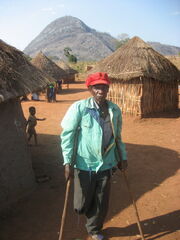
A Mozambique landmine victim.
The Mozambican Civil War of 30 May 1977 to 4 October 1992 began two years after the end of the war of independence due to the politically screwed up nature of the colony under Portuguese rule. It was similar to the Angolan Civil War as both were proxy wars of the Cold War that started soon after the countries gained independence from Portugal. FRELIMO and RENAMO fought it out and ruined the nation. Hundreds of thousands of people died from a war time famine that was attributable to both the war-wacky policies of the RENAMO and FRELIMO organisations.
Non-Mozambique troop numbers in the civil war-
- Zimbabwe 20,000 (?)
- Tanzania 6000 (?)
Tanzania, Zambia, Algeria, the African National Congress (ANC) armed wing, East Germany, France, the UK, the U.S. In the U.S., Kenya, Western Germany, Malawi, Rhodesia, Zimbabwe, Czechoslovakia, Poland, Yugoslavia, Bulgaria, Taiwan, China, Libya, the Peoples' Republic of the Congo, Sweden and Brazil have all had minor or diplomatic only role in at some time in the above conflicts as well.
Cold War politics had noticed both mineral resources, agriculture and geopolitical interests in southern Africa.
Dadra, Nagar Haveli and Goa[]
.
Gallery[]
Maps[]
Also see[]
- MPLA
- UNITA
- Egypt
- RENAMO
- FRELIMO
- Cold War
- West Africa
- North Africa
- Sir Ian Smith
- Horn of Africa
- Southern Africa
- The rules of war
- Integration of Goa
- Winning a hot war
- The Congo and The DRC/Zaire
- African National Congress (ANC)
- Minerals and fuel in central Africa
- Integration of Dadra and Nagar Haveli
- United Nations Security Council Resolution 218
- United Nations Security Council Resolution 275
- United Nations Security Council Resolution 204
- United Nations Security Council Resolution 178
- United Nations Security Council Resolution 289
- United Nations Security Council Resolution 275
- Major Cold War wars that killed over 250,000 people
Links[]
- http://en.wikipedia.org/wiki/Angolan_Civil_War
- http://www.bbc.co.uk/news/world-africa-13037271
- http://en.wikipedia.org/wiki/Angolan_Civil_War
- http://en.wikipedia.org/wiki/Mozambican_Civil_War
- http://en.wikipedia.org/wiki/South_African_Border_War
- http://en.wikipedia.org/wiki/Namibian_War_of_Independence
- http://en.wikipedia.org/wiki/Rhodesian_Bush_War
- http://www.ft.com/cms/s/0/678102c2-59e0-11e4-9787-00144feab7de.html#axzz3SnS60sWm
- http://www.amazon.co.uk/The-Bush-Rhodesia-Extraordinary-Reconnaissance/dp/1581606141
- http://en.wikipedia.org/wiki/Rhodesia
- https://en.wikipedia.org/wiki/Pidjiguiti_massacre
- https://en.wikipedia.org/wiki/African_Party_for_the_Independence_of_Guinea_and_Cape_Verde
